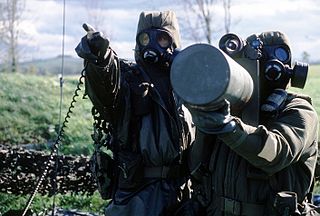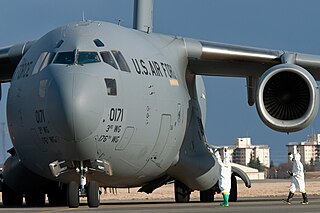
Chemical, biological, radiological and nuclear defense are protective measures taken in situations in which chemical, biological, radiological or nuclear warfare hazards may be present. CBRN defense consists of CBRN passive protection, contamination avoidance and CBRN mitigation.

A hazmat suit is a piece of personal protective equipment that consists of an impermeable whole-body garment worn as protection against hazardous materials. Such suits are often combined with self-contained breathing apparatus (SCBA) to ensure a supply of breathable air. Hazmat suits are used by firefighters, emergency medical technicians, paramedics, researchers, personnel responding to toxic spills, specialists cleaning up contaminated facilities, and workers in toxic environments.

An NBC suit, also called a chemsuit or chem suit or chemical suit is a type of military personal protective equipment. NBC suits are designed to provide protection against direct contact with and contamination by radioactive, biological or chemical substances, and provide protection from contamination with radioactive materials and some types of radiation, depending on the design. They are generally designed to be worn for extended periods to allow the wearer to fight while under threat of or under actual nuclear, biological, or chemical attack. The civilian equivalent is the hazmat suit. The term NBC has been replaced by CBRN, with the addition of a new threat, radiological, meaning radiological weapon.
The National Atmospheric Release Advisory Center (NARAC) is located at the University of California's Lawrence Livermore National Laboratory. It is a national support and resource center for planning, real-time assessment, emergency response, and detailed studies of incidents involving a wide variety of hazards, including nuclear, radiological, chemical, biological, and natural emissions.

Canadian Special Operations Forces Command is a command of the Canadian Armed Forces. It is responsible for all special forces operations that are capable of responding to terrorism and threats to Canadians and Canadian interests around the world.

The Canadian Joint Incident Response Unit (CJIRU) of the Canadian Armed Forces was created "to provide timely and agile broad-based CBRN support to the Government of Canada in order to prevent, control and mitigate CBRN threats to Canada, Canadians, and Canadian interests". It is a sub-unit of the Canadian Special Operations Forces Command (CANSOFCOM).

The Defence Chemical, Biological, Radiological and Nuclear Centre is a United Kingdom military facility at Winterbourne Gunner in Wiltshire, south of Porton Down and about 4 miles (6 km) northeast of Salisbury. It is a tri-service location, with the Army being the lead service. The centre is responsible for all training issues relating to chemical, biological, radiological and nuclear (CBRN) defence and warfare for the UK's armed forces.

The 20th CBRNE Command is the United States Army's Chemical, Biological, Nuclear, Radiological and high-yield explosives headquarters.
RIMPUFF is a local-scale puff diffusion model developed by Risø DTU National Laboratory for Sustainable Energy, Denmark. It is an emergency response model to help emergency management organisations deal with chemical, nuclear, biological and radiological releases to the atmosphere.

The Chemical Biological Incident Response Force (CBIRF) is a unit in the United States Marine Corps responsible for countering the effects of a chemical, biological, radiological, nuclear, or high-yield explosive (CBRNE) incident. They were activated in April 1996 by General Charles C. Krulak, then Commandant of the Marine Corps. The unit is based at Naval Support Facility Indian Head in Indian Head, Maryland and falls under the command of the United States Marine Corps Forces Command.

On December 19, 2006, the Pandemic and All-Hazards Preparedness Act (PAHPA), Public Law No. 109-417, was signed into law by President George W. Bush. First introduced in the House by Rep. Mike Rogers (R-MI) and Rep. Anna Eshoo (D-CA), PAHPA had broad implications for the United States Department of Health and Human Services's (HHS) preparedness and response activities. Among other things, the act amended the Public Health Service Act to establish within the department a new Assistant Secretary for Preparedness and Response (ASPR); provided new authorities for a number of programs, including the advanced development and acquisitions of medical countermeasures; and called for the establishment of a quadrennial National Health Security Strategy.
An emergency use authorization (EUA) in the United States is an authority granted to the Food and Drug Administration (FDA) under sections of the Federal Food, Drug, and Cosmetic Act as added to and amended by various Acts of Congress, including by the Pandemic and All-Hazards Preparedness Reauthorization Act of 2013 (PAHPRA). It does not constitute approval of the drug in the full statutory meaning of the term, but instead authorizes FDA to facilitate availability of an unapproved product, or an unapproved use of an approved product, during a declared state of emergency from one of several agencies or of a "material threat" by the Secretary of Homeland Security.
A Weapons of Mass Destruction Civil Support Team supports civil authorities in the event of the use, or threatened use, of a weapon of mass destruction. CSTs are federally funded units established under Presidential Decision Directive 39. There are 57 National Guard and one Army Reserve full-time teams: one in every U.S. state, Washington, D.C., Puerto Rico, Germany, Guam, and the US Virgin Islands with an additional team each in California, Florida, and New York.

The Head Gear System (HGS) is a future headgear ensemble under development by the U.S. Army. HGS attempts to integrate head protection against ballistics, fragmentation, blast, blunt force, flash heat, and noise into a single lightweight, modular, scalable headgear system. Program Executive Office (PEO) Soldier is working to develop a Soldier-centric Head Gear System (HGS) that provides ballistic and traumatic brain injury protection as well as face, neck, and hearing protection. The HGS also will incorporate integrated sensor inputs along with display hardware and software for increased situational awareness. The system will address technology gaps identified by the Capabilities Development Integration Directorate of the Army's Training and Doctrine Command.

The United States Army CBRN School (USACBRNS), located at Fort Leonard Wood, Missouri, is the primary American training school specializing in military Chemical, Biological, Radiological, and Nuclear (CBRN) defense. Until 2008, it was known as the United States Army Chemical School.
Operations Plus WMD is a training level in dealing with hazardous materials.

The Emergency Management (EM) career field is the United States Air Force's (USAF) primary organization responsible for implementing an installation-level EM program. Emergency Managers, also known by the Air Force Specialty Code (AFSC) 3E9X1, are the Air Force's subject matter experts for all non-medical Chemical, Biological, Radiological and Nuclear (CBRN) passive defense and consequence management matters.
During wartime operations, 3E9X1s are assigned to CBRN reconnaissance teams responsible for detecting, identifying, quantifying, and collecting CBRN material ensuring mission continuation and force survivability.

The Pandemic and All-Hazards Preparedness and Advancing Innovation Act (PAHPAI) is legislation introduced and passed by the U.S. Congress in 2019 that aims to improve the nation's preparation and response to public health threats, including both natural threats and deliberate man-made threats.
14 CBRN Regiment, Sri Lanka Engineers is a regiment of the Sri Lanka Army that focuses on countering chemical, biological, radiological and nuclear (CBRN) hazards in the country. The Sri Lanka Navy and Sri Lanka Air Force also maintain CBRN units in addition to the Army's CBRN regiment. The regiment evolved from the first CBRN squadron that Major General Jagath Gunawardena, the current colonel-commandant of Sri Lanka Engineers, established.











